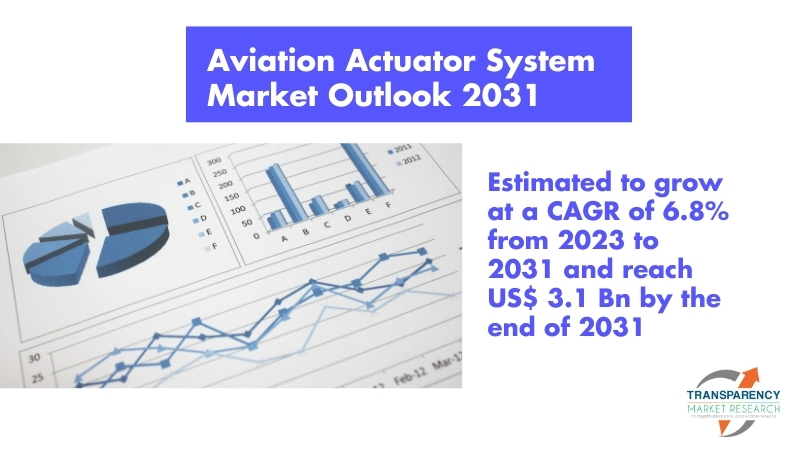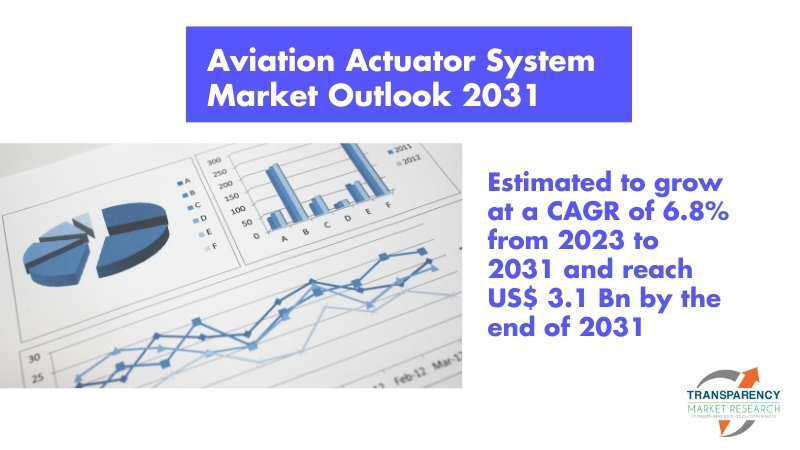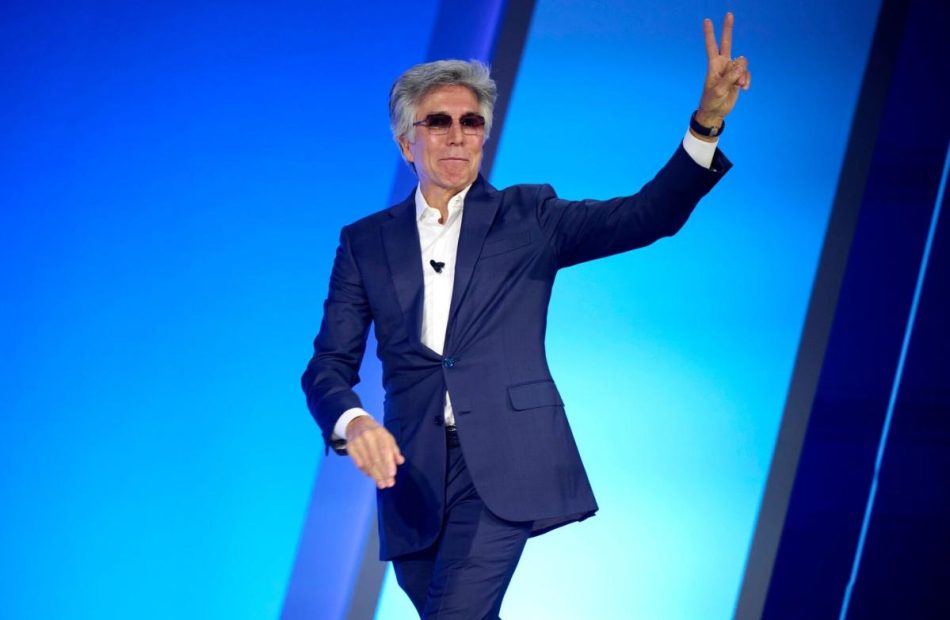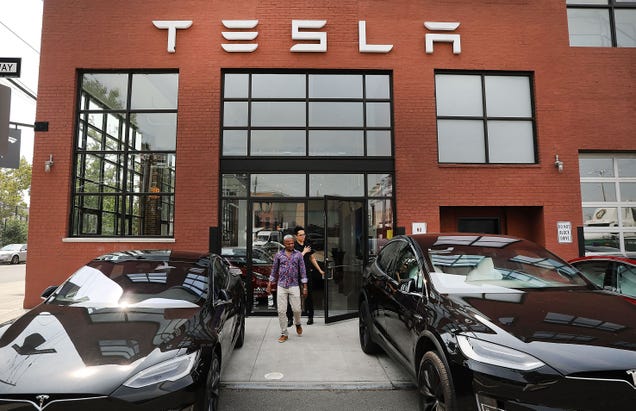Aviation Actuator System Market Size & Share to Surpass USD 3.1 billion by 2031, Rising at a CAGR of 6.8% | Analysis by Transparency Market Research, Inc.
Wilmington, Delaware, United States, Transparency Market Research Inc. -, Oct. 24, 2024 (GLOBE NEWSWIRE) — The aviation actuator system market (항공 액추에이터 시스템 시장) was worth US$ 1.7 billion in 2022. A CAGR of 6.8% is predicted from 2023 to 2031, leading to a market value of US$ 3.1 billion by 2031. Actuators are being replaced by electric actuators in the aviation industry as hydraulic actuators and pneumatic actuators become obsolete. Electric actuators provide power efficiency, are lightweight, compact, fuel-efficient, and reliable, and are highly advantageous.
Electric actuation systems, which address issues pertaining to fluid control, cleaning, heating, and control, are expected to improve aircraft performance. Aviation actuator systems are a beneficial component of sustainable electric aircraft, contributing to the development of eco-friendly aircraft. Electronic systems are becoming increasingly important to aircraft as they become more dependent on electronic systems.
With the development of the next generation of aircraft, more electronic systems will be used, which will require high reliability. Increasing demand for advanced electronic components will lead to the popularity of electronic actuator systems in the aviation industry. Dispatch systems offer benefits such as greater efficiency and improved dispatch availability, which will increase demand for the services.
Download sample PDF copy of report: https://www.transparencymarketresearch.com/sample/sample.php?flag=S&rep_id=51987

Key Findings of the Market Report
- Based on the actuator type, electric actuators are expected to be in high demand in aviation actuator systems.
- In terms of application, the flight control segment is predicted to drive demand for aviation actuator systems.
- The demand for aviation actuator systems is primarily driven by commercial aviation.
- Asia Pacific accounted for a significant share of the global market in 2022.
Global Aviation Actuator System Market: Growth Drivers
- Global air travel demand has become a major driving force in the aviation industry. To meet this demand, airlines are increasing their fleets to meet an increasing demand for advanced and efficient actuator systems.
- As aircraft technology advances, such as introducing more electric aircraft (MEAs) and fly-by-wire systems, sophisticated actuator systems are in increasing demand. In addition to improving performance and efficiency, these systems are lighter and more efficient.
- The aviation industry is subject to strict safety regulations. Various aircraft components, including control surfaces and landing gear, rely heavily on actuator systems to ensure their safe and reliable operation. Safety regulations and standards may contribute to the demand for high-performance actuators.
- Aviation manufacturers are developing more fuel-efficient and environmentally friendly aircraft as sustainability and fuel efficiency become more important. Advanced actuator systems can optimize aircraft performance and reduce fuel consumption.
- Modern military aircraft incorporate advanced technologies for better agility, stealth, and performance, which also drives demand for advanced actuator systems. Next-generation military aircraft and increased defense budgets can boost the aviation actuator market.
- Aerospace researchers and engineers continue to develop advanced materials, sensors, and actuation mechanisms through ongoing research and development efforts. These innovations will likely make actuator systems more efficient and newer.
Global Aviation Actuator System Market: Regional Landscape
- Aviation actuator systems are expected to be a significant market in Asia Pacific. A significant increase in air travel demand has been observed in Asia, along with economic growth and rising incomes. As passenger traffic increases, new aircraft are needed, creating a demand for aviation actuator systems.
- Several Asia Pacific countries have seen a rise in air travel due to their burgeoning middle-class population. People with higher incomes are able to fly more often, resulting in an expansion of airline fleets in the region, driving the demand for advanced aviation technologies, such as actuators.
- Commercial and military fleets in several Asia Pacific countries are being modernized. Modernization often involves improving aircraft performance, safety, and reliability by adopting new and more efficient actuator systems.
- As defense budgets in the Asia Pacific region have increased, new military aircraft have been purchased. Advanced actuator systems are often integrated into modern military aircraft to ensure maneuverability and precise control.
Unlock Growth Potential in Your Industry! Download PDF Brochure: https://www.transparencymarketresearch.com/sample/sample.php?flag=S&rep_id=51987
Global Aviation Actuator System Market: Competitive Landscape
Technology advancements and advanced materials incorporated into aviation actuator system design have created substantial growth opportunities for companies in this field. Leading players are launching new devices to enhance their product portfolios, and a business expansion is being invested to increase profitability and productivity.
Key Players Profiled
- Aero Space Controls Corporation
- General Electric
- Honeywell International Inc.
- ITT INC.
- Microsemi
- Moog Inc.
- PARKER HANNIFIN CORP
- Collins Aerospace
- Safran
- SAM GmbH
- Crissair, Inc.
- Woodward Inc.
Key Developments
- In October 2022, Moog Inc., which manufactures, integrates, and designs discrete and integrated control systems, launched and retrieved an X-61A Gremlins Air Vehicle (GAV) on its fourth flight test. With three GAVs, Gremlins conducted four individual flight sorties, including an airborne recovery mission that lasted 1.4 hours.
- In July 2023, Safran acquired Collins Aerospace’s actuation and flight control business. By acquiring ATA27, Safran gained global leadership in flight control (ATA27) and actuation.
Global Aviation Actuator System Market: Segmentation
By Actuator Type
- Mechanical Actuator
- Hydraulic Actuator
- Electric Actuator
- Others (Including Piezoelectric Actuator, Pneumatic Actuator, and Electrohydrostatic Actuator)
By Application
- Flight Control
- Auxiliary Control
- Utility Actuation
- Others (Including Weapons Bay Door Drive)
By End Use
- Commercial Aviation
- Defense
By Region
- North America
- Europe
- Asia Pacific
- South America
- Middle East & Africa
Buy this Premium Research Report: https://www.transparencymarketresearch.com/checkout.php?rep_id=51987<ype=S
More Trending Reports by Transparency Market Research –
AI in Aviation Market (航空市場における AI)- The industry was valued at US$ 713.3 Mn in 2022 and it is projected to grow at a CAGR of 37.0% from 2023 to 2031 and reach more than US$ 12.1 Bn by the end of 2031
Sustainable Aviation Fuel Market (Markt für nachhaltigen Flugtreibstoff)- The global industry was valued at US$ 186.6 Mn in 2022 and it is projected to grow at a CAGR of 26.2% from 2023 to 2031 and reach more than US$ 402.0 Bn by the end of 2031
About Transparency Market Research
Transparency Market Research, a global market research company registered at Wilmington, Delaware, United States, provides custom research and consulting services. Our exclusive blend of quantitative forecasting and trends analysis provides forward-looking insights for thousands of decision makers. Our experienced team of Analysts, Researchers, and Consultants use proprietary data sources and various tools & techniques to gather and analyses information.
Our data repository is continuously updated and revised by a team of research experts, so that it always reflects the latest trends and information. With a broad research and analysis capability, Transparency Market Research employs rigorous primary and secondary research techniques in developing distinctive data sets and research material for business reports.
Contact:
Transparency Market Research Inc.
CORPORATE HEADQUARTER DOWNTOWN,
1000 N. West Street,
Suite 1200, Wilmington, Delaware 19801 USA
Tel: +1-518-618-1030
USA – Canada Toll Free: 866-552-3453
Website: https://www.transparencymarketresearch.com
Email: sales@transparencymarketresearch.com
Follow Us: LinkedIn| Twitter| Blog | YouTube

© 2024 Benzinga.com. Benzinga does not provide investment advice. All rights reserved.
ServiceNow Sales Growth Fails to Impress AI-Hungry Investors
(Bloomberg) — ServiceNow Inc. reported strong third-quarter sales and bookings as the software company expands its suite of AI tools.
Most Read from Bloomberg
Subscription sales, which account for the bulk of ServiceNow’s revenue, increased 23% to $2.7 billion in the period, the company said Wednesday in a statement. Current remaining performance obligation, a measure of booked sales, increased 26% in the period ending Sept. 30. Both exceeded analysts’ estimates.
The Santa Clara, California-based company makes applications that help companies organize and automate their personnel and information technology operations. Like its peers, ServiceNow is baking generative AI features into its products and offers a pricier tier with those tools.
The company’s main generative AI assistant product, Now Assist, is the fastest-growing in company history, Chief Executive Officer Bill McDermott said in an interview. The average contract premium for users of Now Assist is 30%, he added.
The shares hit a record high Thursday in New York, jumping about 6%. Investors were initially unimpressed with the results, with the stock trading down Wednesday evening. The shares had increased 28% this year through Wednesday’s close. That’s more than twice the rally seen in the iShares Expanded Software ETF, which is often used as a sector benchmark.
The results “validate the company’s rare standing in enterprise software,” wrote Tyler Radke, an analyst at Citigroup. He cited strong execution in a tough environment for tech spending and early monetization of generative AI.
In recent weeks, ServiceNow and software peers like Salesforce Inc. and Microsoft Corp. have begun emphasizing AI “agents” that can complete tasks without user supervision. Some customers are already trying ServiceNow’s agents, which will be released more broadly next month, McDermott said. Once the agents are fully rolled out, they’ll be priced differently from other products, McDermott added.
For the current quarter ending in December, ServiceNow projected subscription revenue of about $2.88 billion, just ahead of analyst estimates. The company expects near-term bookings to rise 21.5%.
This bookings guidance was effectively “good, but not great,” Kirk Materne, an analyst at Evercore ISI, said in a note. He added that the company tends to issue conservative forecasts for the fourth quarter.
The Plaza at Hazeltine Multifamily Community in Chaska, Minn. to Celebrate Grand Opening on October 30
Four-story, 112-unit community-centered property offers unique breezeway and the best of modern amenities
CHASKA, Minn., Oct. 24, 2024 /PRNewswire/ — Trident Development, a Minnesota-based firm specializing in the acquisition and development of luxury rental apartments, is set to celebrate the opening of The Plaza at Hazeltine, a multifamily community located at 1130 Hazeltine Boulevard, with its project partners, city representatives and residents. The event will begin at 4 p.m. CT on Wednesday, October 30.
“From the beginning, our goal in developing The Plaza at Hazeltine has been to create a destination that is seamlessly connected to the surrounding community,” said Carin Bzdok, vice president at Trident Development. “By working shoulder-to-shoulder with our partners and the city of Chaska, we have achieved that goal and then some. With multiple living options and a wide range of modern amenities, residents are immersed in this wonderful city, taking pride in truly calling this home.”
Located at the southwest corner of Hazeltine Boulevard and Hundertmark Road, The Plaza at Hazeltine features studio/alcove, one, two and three-bedroom apartment options with luxury finishes, modern appliances and golf course views. Residents have access to an underground, climate-controlled parking garage with 100 stalls, and partial ground level covered parking with 30 stalls. The first residents began moving in in early September 2024.
The Plaza at Hazeltine is conveniently situated near a bustling retail area with Kohl’s, McDonald’s, Aldi, Chipotle and Starbucks. The location makes the most of its pedestrian walkways to the retail shops and recreational facilities, including The Loop at Chaska public golf course and the world-renowned Hazeltine National Golf Club.
Amenities include a large outdoor patio with pergola, grilling stations and firepit with comfortable seating, walking trails, a children’s play area, outdoor putting green, dog park, pet wash, bike racks, spacious community room, coffee bar, package delivery room, expansive fitness room, golf simulator, plaza breezeway through the building and a fourth-floor sky deck featuring a rooftop patio.
The general contractor for The Plaza at Hazeltine is Lyon Contracting and the property is managed by Village Green.
For more information on The Plaza at Hazeltine, visit plazaathazeltine.com.
About Trident Development, LLC
With offices and properties in Minnesota and Montana, Trident Development specializes in creating high-quality, safe, and well-appointed senior living and luxury apartment communities. Through comprehensive market research, each project is tailored to meet the specific needs of its community. With a team of seasoned real estate professionals, Trident oversees every stage from site selection to construction financing, ensuring excellence from inception to completion and beyond. For more information, visit tridentdevelopmentmn.com.
![]() View original content to download multimedia:https://www.prnewswire.com/news-releases/the-plaza-at-hazeltine-multifamily-community-in-chaska-minn-to-celebrate-grand-opening-on-october-30-302286027.html
View original content to download multimedia:https://www.prnewswire.com/news-releases/the-plaza-at-hazeltine-multifamily-community-in-chaska-minn-to-celebrate-grand-opening-on-october-30-302286027.html
SOURCE Trident Development, LLC
Market News and Data brought to you by Benzinga APIs
© 2024 Benzinga.com. Benzinga does not provide investment advice. All rights reserved.
Tesla stock soars 13% thanks to an earnings beat and Elon Musk's 'best guesses'
Tesla (TSLA) stock is staying strong in trading Thursday after the company delivered earnings that largely surprised Wall Street and Elon Musk delivered a new round of optimistic forecasts.
The automaker reported improved operating profit margins, automotive gross profit margins excluding the benefits of regulatory credits, and better earnings per share than analysts had expected for the July to September quarter. It also reported better than expected net income and its lowest cost per goods sold ever, at about $35,100 per vehicle.
It’s the first time in seven quarters — that’s almost two years — that Tesla has grown its earnings.
Cannacord Genuity analyst George Gianarikas reiterated a buy rating and raised his price target to $278 per share from $254 per share. A number of analysts across firms like KGI Securities and Goldman Sachs (GS) likewise raised their price targets. J.P. Morgan (JPM) analysts maintained an underweight rating and raised their price target to $135 per share from $130 per share.
“There is more wood to chop for Tesla and this recovery story still has some challenges ahead to convince the Street that 2025 will be a true inflection point year,” Wedbush Securities analyst Dan Ives said in a note Thursday, adding that the Tesla has taken its “first major step” to recovery. Wedbush maintained its $300 per share price target and an outperform rating.
Tesla stock was down roughly 2% when the market closed on Wednesday. As of early Thursday morning, shares have gained more than 13%, returning the stock to about here it was before Tesla’s “underwhelming” robotaxi product demonstration left Wall Street with more questions than answers.
On Wednesday, Musk gave investors a lot to look forward to, assuming that his promises and “best guess” estimates ring true. He reiterated that the company aims to begin scaling production of its Cybercab robotaxis in 2026, with plans to eventual make between 2 million and 4 million units per year; that’s more units than Tesla sells electric vehicles.
“That will be in more than one factory, but I think it’s at least 2 million units a year, maybe 4 million ultimately,” Musk said, adding that he’s talking about his “best guesses.”
Musk also said Tesla expects to begin offering rideshare services next year in at least two states, California and Texas, where he also plans to get regulatory approval for “fully autonomous unsupervised” Full Self-Driving (FSD). Many valuations of Tesla’s current and future stock price account for a planned robotaxi network, which Musk has called a “combination of Airbnb (ABNB) and Uber (UBER).”
Tesla has been operating its own rideshare network for employees at its facilities in California’s Bay Area using current models and a driver at the wheel, executives said Wednesday. Palo Alto, California, is in talks to use Tesla’s newly-unveiled robotaxi in its rideshare program, but the company doesn’t plan to begin making those cars until 2026.
Tesla has, so far, sold more than 1.29 million electric vehicles in 2024, including 462,890 units delivered between July and September. That doesn’t give the company much wiggle room to reach or beat 1.8 million sales — its 2023 record — by the end of the year. But the automaker said it expects “slight growth” in deliveries this year, which would require fourth-quarter sales of more than 516,000 units.
Musk said his “best guess” is for deliveries to reach 20% to 30% growth next year, citing Tesla’s plans to begin selling more affordable models in early 2024.
Billionaire Ken Griffin Sold 79% of Citadel's Stake in Nvidia and Is Piling Into Another Artificial Intelligence (AI) Stock With a Competitive Moat
A little over two months ago, on Aug. 14, investors received what can arguably be described as the most important data release of the third quarter — and I’m not talking about any inflation report.
No later than 45 calendar days following the end to a quarter, institutional investors with at least $100 million in assets under management (AUM) are required to file Form 13F with the Securities and Exchange Commission. This filing tells investors which stocks, exchange-traded funds (ETFs), and occasionally options, Wall Street’s top money managers purchased and sold in the latest quarter (in this case, the June-ended quarter).
As you might imagine, professional and everyday investors are particularly interested in seeing how Wall Street’s smartest asset managers are approaching artificial intelligence (AI) stocks. AI has been the hottest trend over the last two years, with the analysts at PwC expecting this technology to provide a $15.7 trillion boost to the global economy by 2030.
Interestingly, 13Fs from the second quarter show that billionaire investors, including Citadel’s Ken Griffin, have a mixed view of the companies powering the AI revolution.
Since its inception in 1990, Citadel’s hedge fund has been more successful generating investment gains than any other hedge fund. It’s why investors wisely pay attention to what Griffin and his team are buying and selling.
During the June-ended quarter, Griffin oversaw the disposition of a sizable percentage of his fund’s stake in market-leading AI stock Nvidia (NASDAQ: NVDA), but chose pile into another AI company that appears to have a virtually insurmountable moat.
Let me preface this discussion by pointing out that Citadel is an active hedge fund with countless positions, and it often hedges its common stock holdings with put and/or call options. With this being said, perhaps no sell-side activity stood out more during the second quarter than Griffin and his crew shedding 79% of their fund’s stake in Nvidia.
Since 2023 began, Nvidia’s stock has gained 844%, as of the closing bell on Oct. 18, 2024, and tacked on close to $3 trillion in market cap. These are never-before-seen gains from a market-leading business, which suggests that profit-taking played at least some role in Citadel reducing its sizable position. But there’s a reasonable chance this selling activity is about more than benign profit-taking.
To start with, competition is coming at Nvidia from all angles. Rival chipmakers are developing and ramping production of AI-graphics processing units (GPUs) designed to complete with Nvidia’s ultra-popular H100 GPU and next-generation Blackwell GPU architecture. Although Nvidia’s hardware shouldn’t have any trouble maintaining a computing advantage in AI-accelerated data centers, competing chips are cheaper and may be easier for businesses to get their hands on.
Jobless Claims Fall More Than Expected, Continuing Benefits Surge To Nearly 3-Year Highs: Labor Market At 'Full Employment,' Analyst Says
The U.S. labor market continues to exhibit signs of strength, with initial jobless claims falling sharply for the week ending Oct. 19. The number of individuals filing for unemployment benefits dropped more than expected, signaling a robust job market as Americans approach a presidential election in less than two weeks.
Jobless Claims Slow
Initial jobless claims came in at 227,000 last week, a decline of 15,000 from the previous week. This marked the largest week-over-week drop since August 2024 and came in below economist forecasts of 242,000. The sharp decline is a sign that fewer Americans are being laid off, further reflecting the labor market’s resilience.
The four-week moving average for initial claims, which helps smooth out volatility, rose slightly to 238,500, up from 236,500 the previous week. This marked the highest level since early August.
A less optimistic signal flashed in continuing jobless claims — a metric that tracks the number of people still receiving unemployment benefits after an initial filing.
For the week ending Oct. 12, continuing claims increased to 1.897 million, up from 1.869 million in the previous week. This is the highest level seen since mid-November 2021 and significantly higher than the expected 1.880 million, suggesting that some individuals are finding it harder to transition back into employment.
Economist Insights: What Does It Mean?
Michael Gayed, CFA, anticipated on Wednesday that the U.S. labor market remains incredibly tight, a factor that could have wider economic implications. “The labor market is at a level that the central bank has traditionally called full employment,” Gayed said.
“That’s good for growth, and I think that’s generally being reflected in forward-looking GDP forecasts, but it also creates another set of problems. We may be seeing yields rise as investors remain risk-on and the negative correlation between stocks & bonds returns. But I also think it has a lot to do with inflation risk,” he added.
Gayed also indicated the current environment of solid growth, a tight labor market and greater liquidity is likely contributing to upward pressure on interest rates.
“Fiscal and monetary conditions could ignite a further boom in risk asset prices, but subsequent inflation and negative credit conditions could still usher in the big credit event after that.”
Market Reactions
U.S. equity markets reacted positively to the latest labor market data in premarket trading on Thursday. Futures on the S&P 500 climbed 0.5% by 8:45 a.m. in New York, signaling a potential rebound after Wednesday’s losses.
On Wednesday, the S&P 500, as tracked by the SPDR S&P 500 ETF Trust SPY, declined by 0.9%, marking the third consecutive day of losses.
Contracts on the Nasdaq 100 surged 0.9%, driven by strong earnings from Tesla, which helped buoy the tech-heavy index. The EV giant was up 15%. Futures on the Dow Jones Industrial Average were relatively flat.
In the currency markets, the U.S. Dollar Index (DXY), which measures the dollar’s strength against a basket of other currencies and is tracked by the Invesco DB USD Index Bullish Fund ETF UUP, weakened slightly by 0.2%,
In the bond market, Treasury yields softened slightly on Thursday, with the 10-year Treasury yield falling to 4.22%, though yields remained elevated for the week.
Gold prices, as tracked by the SPDR Gold Trust GLD, rebounded 0.9%, after dropping 1.2% in Wednesday’s trading.
Read Next:
Photo via Shutterstock.
Market News and Data brought to you by Benzinga APIs
© 2024 Benzinga.com. Benzinga does not provide investment advice. All rights reserved.
5 High-Yield Dividend Stocks to Buy Without Hesitation
Dividend stocks with substantial yields tend to outperform when the Federal Reserve begins lowering interest rates. These moves reflect portfolio managers shifting capital away from bonds and into stable, income-producing equities.
Among companies paying dividends above 4%, five stand out for their market strength and sustainable payouts. With yields ranging from 4.5% to 8.7%, these businesses have the cash flow and competitive positions to maintain their attractive dividends. Read on to find out more about these five top dividend payers.
British American Tobacco (NYSE: BTI) is a global tobacco powerhouse, operating in over 180 markets worldwide. The company rewards shareholders with an exceptional 8.71% dividend yield, prudently supported by a 59.1% payout ratio.
Despite a robust 19.1% gain year to date, British American Tobacco shares remain remarkably affordable at just 7.29 times forward earnings. The company’s strategic approach is twofold: maximizing profitability from traditional cigarettes through strong pricing power, while aggressively expanding into reduced-risk, next-generation products to ensure long-term sustainability.
With a commanding presence in emerging markets, the company is well-positioned for future growth. Its substantial investments in vapor and heated tobacco products underscore management’s commitment to innovation and sustainable business practices in an evolving industry landscape.
Altria Group (NYSE: MO) dominates the U.S. tobacco market through its iconic Marlboro brand. Offering pure-play exposure to American tobacco, the company boasts an attractive 8.32% dividend yield. Even after a meteoric 24.1% rise year to date, Altria shares remain a compelling value at just 9.48 times forward earnings.
With Marlboro commanding over a 40% market share, Altria Group wields exceptional pricing power to counter volume declines. The company’s strategic $2.75 billion acquisition of NJOY in 2023 — one of few FDA-approved e-cigarette manufacturers — demonstrates its commitment to expanding beyond traditional tobacco.
This proven business model combines premium pricing with operational efficiency to maintain robust profit margins. While U.S. cigarette volumes decline, Altria’s sophisticated pricing strategy and targeted investments in smokeless alternatives position the company for sustained profitability.
Pfizer (NYSE: PFE), a global pharmaceutical leader, produces a broad range of medicines and vaccines. The company offers investors an attractive 5.81% dividend yield, while shares trade at a modest 10.3 times forward earnings.
QuantumScape soars as production of its initial B-sample cells begins
Investing.com — Quantumscape Corp (NYSE:QS) saw its shares soar more than 17% in premarket trading Thursday after the company reported Q3 results and offered an update on battery cell testing for automotive customers.
For Q3, the company posted a loss per share of $0.23, matching analyst expectations.
The battery maker reported an adjusted earnings before interest, taxes, depreciation, and amortization (EBITDA) loss of $71.6 million, which was slightly higher than the anticipated $70.5 million loss.
The San Jose-based battery developer also provided guidance, indicating it is on track to record an adjusted EBITDA loss between $280 million and $300 million for the year. This forecast aligns with the company’s original projections, although it tends toward the upper end of the range.
Most notably, QuantumScape revealed it has started the production of low volumes of its first B-sample cells, which are now being shipped for testing by automotive customers. Achieving this milestone was highlighted as the company’s most critical goal for 2024.
The B-samples of QuantumScape’s initial product, the QSE-5, have demonstrated an energy density exceeding 800 watt-hours per liter (Wh/L) and a fast-charging capability that allows charging from 10% to 80% in less than 15 minutes.
The company stated that, to the best of its knowledge, these cells are the first anode-free solid-state lithium-metal cells to be manufactured for use in next-generation automotive applications.
“Now that the product design and performance profile is set, and we have established a baseline process, we will continue to ship samples, get customer feedback, and iterate to refine our processes,” said QuantumScape.
It also noted that it has to notably improve on metrics such as cell reliability, yield and equipment productivity, among others.
“We need higher volumes to achieve these targets, and that requires bringing our advanced Cobra separator process into production, which we continue to target for 2025,” stated the company.
Related Articles
QuantumScape soars as production of its initial B-sample cells begins








